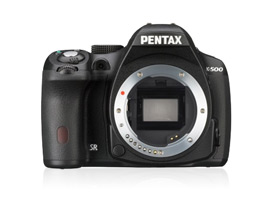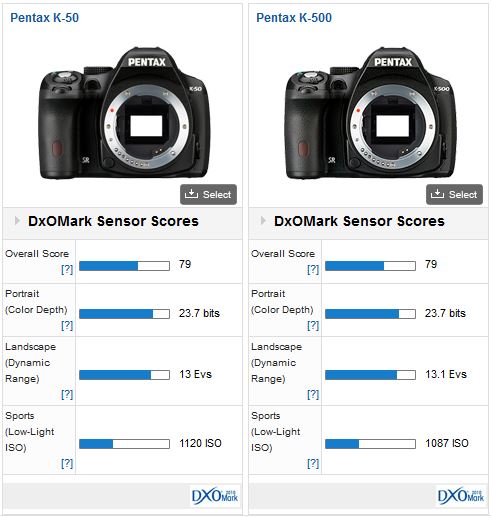Introduction
At $499 the Pentax K-500 is a slightly stripped down version of the K-50, adopting the same stabilized 16MpIx resolution CMOS sensor and body of its sibling, yet lacking the weather-resistant construction, leveling option and lithium ion battery. While the K-500 is supplied with AA batteries instead (in the US only), opting for this model over the K-50 will save $200. While the lithium ion battery and charger can be bought separately in the US it’s supplied as standard equipment in other markets (in place of the AA batteries).
In nearly every other respect the two cameras are identical. It has a 1/6000sec top shutter speed (with a 1/180sec flash sync), can shoot continuously at up to 6fps and captures video for up to 25mins using 1080p at 30/25/24fps in MPEG-4 AVC/H.264 using one of three compression levels. The K-500 measures 129×96.5x70mm and weighs just 650g with battery and SD card, and is available now.
A DxOMark Sensor rating of 79 points is an excellent score, and very close to the best tested APS-C size sensors. The sensor has a very high color depth (at 23.7 bits) and an excellent dynamic range (of 13.1 Evs).
In good lighting, these scores put the K-500 almost on a par with the best full-frame models. In our low-light tests, the K-500 also performs very well for a APS-C camera, but not quite matching much more expensive best full-frame cameras with their larger surface area and larger sensels.
Overall, with no unexpected results, the sensor performs very well indeed.
Compared with its more-pricey K-50 twin, there are no surprises here.
The K-500 sensor achieves the same DxOMark score and practically identical scores for Color Depth, Dynamic range and Low-Light ISO, confirming the two adopt the same sensor. If you can live without the extra features (weatherproofing, leveling correction and display and the li-ion battery) then the K-500 makes a lot of sense.
Compared to rival offerings the Pentax easily holds its own. Against the Canon EOS 100D (Rebel SL1) the individual sensor scores easily favor the Pentax, though bear in mind Canon are pushing their sensor tech in an additional direction its ‘Hybrid CMOS AF II” system, which uses a number of dedicated pixels for phase detection AF.
The Canon sensor also has a slightly higher pixel count and a smaller surface area (22.3×14.9mm against 23.7×15.7mm for Pentax). Against the Nikon D3200 the scores are very close but, given the higher pixel count (and potentially higher resolving power), the Nikon would have the edge.
If you don’t intend to test the weather-resistant sealing of the K-50 and aren’t too concerned about the other features offered, the saving of $200 or thereabouts is not insignificant. Add to that the K-500 uses the same sensor (and most of everything else), at $599 with the 18-55mm f/3.5-5.6 AL kit lens it’s a sorely tempting option.









DXOMARK encourages its readers to share comments on the articles. To read or post comments, Disqus cookies are required. Change your Cookies Preferences and read more about our Comment Policy.